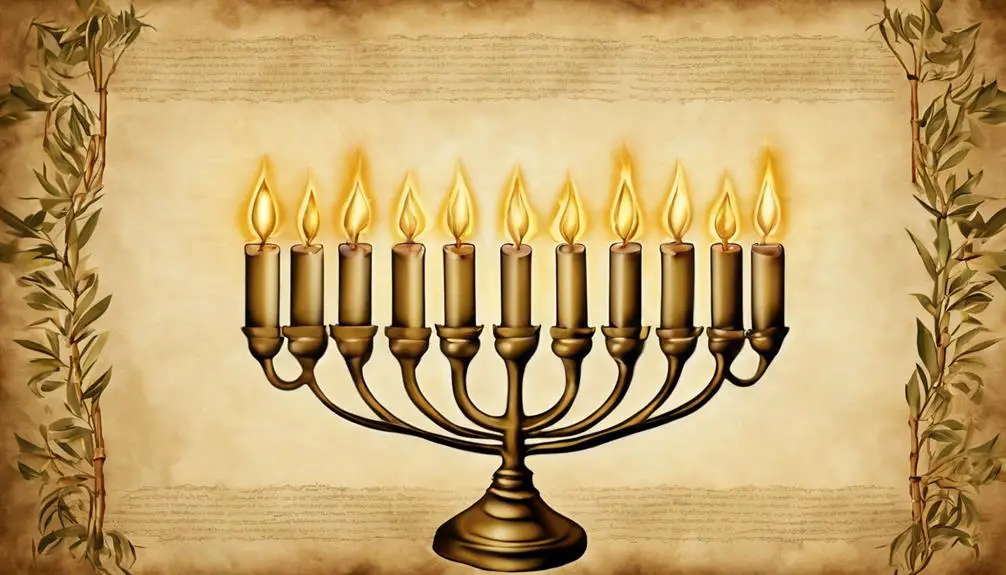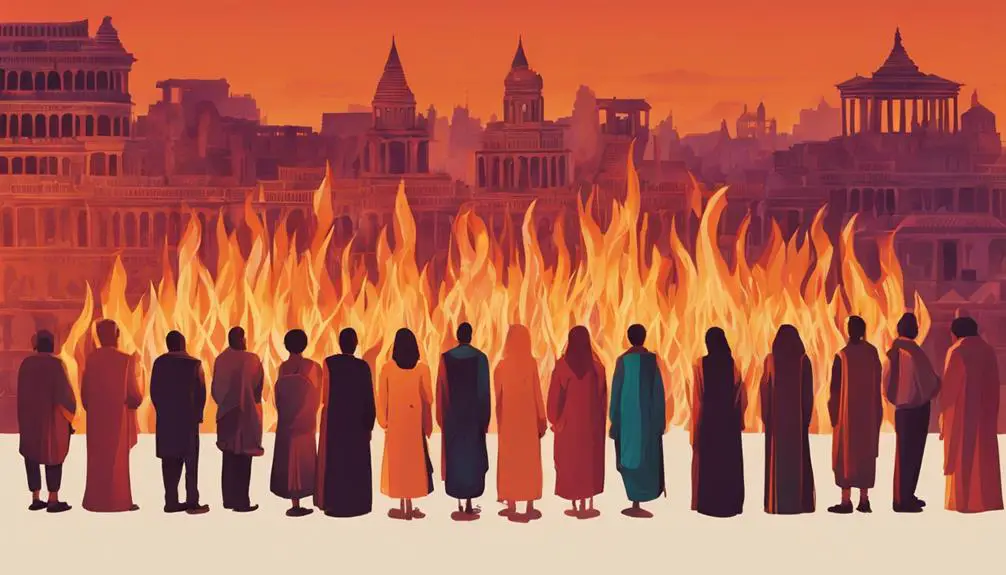Discover the profound spiritual significance of the number 50 in the Bible, a symbol of liberation, renewal, and divine celebration.

Significance of the Number 50 in the Bible
Imagine standing amidst a vast, vibrant celebration, marking a moment of jubilation and freedom that comes once every 50 years. You've stumbled upon the biblical significance of the number 50, a symbol woven into the fabric of ancient texts, epitomizing spiritual renewal, liberation, and festivity.
From the Jubilee Year, which commands the release of all debts and the liberation of slaves, to the day of Pentecost, celebrating the descent of the Holy Spirit 50 days after Passover, this number holds profound spiritual and historical weight. As you ponder its implications, you'll find yourself drawn into a deeper exploration of how these ancient practices influenced not just historical events, but the very essence of faith and morality.
Key Takeaways
- The number 50 marks the Jubilee year, symbolizing societal renewal and economic justice through mechanisms like land restoration and debt forgiveness.
- Pentecost, celebrated 50 days after Passover, signifies the descent of the Holy Spirit and the transformative birth of the Christian Church.
- In religious festivals, offering 50 loaves represents spiritual nourishment, communal unity, and the grace of divine provision.
- The symbolism of 50 is tied to spiritual renewal, serving as a beacon for societal reset, personal renewal, and divine transformation.
The Jubilee Year

In the context of biblical tradition, the Jubilee Year, marked every 50th year, embodies a profound mechanism for societal renewal and economic justice. This period isn't just a time marker; it's a visionary blueprint for resetting societal imbalances. Central to its ethos are the principles of land restoration and debt forgiveness, which together forge a path towards rectifying economic disparities.
You'll find that land restoration isn't merely about returning physical property. It's a symbolic act of ensuring that wealth and resources don't become perpetually locked within a certain segment of society. By mandating the return of land to its original owners or their heirs, the Jubilee Year ensures that the accumulation of wealth is periodically redistributed, preventing the entrenchment of social inequalities.
Similarly, debt forgiveness during the Jubilee acts as a safeguard against the perpetual cycle of poverty and debt slavery. It acknowledges that, left unchecked, debts can become chains that bind individuals and families across generations, stifling their economic mobility. By wiping the slate clean every 50 years, the Jubilee Year offers a fresh start, enabling individuals to participate equitably in the economy once more.
Pentecost: The 50th Day

Reflecting the theme of renewal and liberation found in the Jubilee Year, Pentecost emerges as another significant event marked by the number 50, celebrating the descent of the Holy Spirit and the birth of the Christian Church. On this day, you're reminded that the Apostolic Church wasn't just an institution but a living organism, animated by the Holy Spirit's power. It's a pivotal moment in religious history, underscoring the Holy Spirit's role in guiding and empowering believers.
The number 50, in this context, symbolizes not just a time span but a profound transformation. Through the Holy Spirit, individuals are united into one body, marking the transition from the Old Covenant to the New. This event highlights several key aspects:
- The fulfillment of Jesus' promise to send a helper
- The empowerment of the Apostles to preach with boldness
- The initial widespread dissemination of the Gospel
- The establishment of the Church as a community of believers
Analyzing Pentecost through the lens of the number 50, you see a clear message of continuity and renewal. It's a testament to the enduring and transformative power of the Holy Spirit, central to the life and mission of the Apostolic Church.
50 Loaves for Festivals

Diving into the tradition of Loaves for Festivals, you'll find that the offering of fifty loaves plays a pivotal role in symbolizing spiritual nourishment and communal unity within these celebrations. This ceremonial offering isn't just about feeding multitudes physically but also about fulfilling a deeper, spiritual hunger that binds the community together.
The act of presenting fifty loaves, a number deeply embedded in the fabric of biblical symbolism, transcends the mere act of eating. It becomes a profound statement about abundance, grace, and the provision of the divine.
In the ancient context, these offerings weren't merely obligatory; they were a tangible expression of gratitude and dependency on a higher power. By analyzing this practice, you recognize how the number fifty, intertwined with the concept of feeding multitudes, encapsulates a multifaceted layer of meaning. It wasn't just about the physical sustenance provided by the loaves but also about the spiritual sustenance offered through the act of communal sharing and ceremonial offerings.
This tradition underscores the importance of unity and collective spiritual nourishment, highlighting how essential it's for a community to come together in celebration and thanksgiving.
The Tabernacle's Dimensions

While exploring the symbolic significance of the number 50 in biblical traditions, it's crucial to examine the dimensions of the Tabernacle, which reveal profound insights into divine order and spiritual harmony. The Tabernacle, a movable sanctuary for the Israelites during their desert wanderings, wasn't just a physical structure but a symbol of the divine presence among them. Its dimensions, materials, and construction details are meticulously described in the Bible, each carrying deep spiritual meaning.
The curtain layers and material symbolism are particularly noteworthy. Consider these aspects:
- Curtain layers: They served as barriers and connectors between the sacred and the profane, symbolizing progressive sanctification and intimacy with God.
- Gold: Symbolizing divinity and kingship, it adorned the most sacred objects, reflecting God's glory and purity.
- Blue, purple, and scarlet yarns: These colors represented heaven, royalty, and sacrifice, respectively, underscoring the Tabernacle's role as a bridge between God and humanity.
- Acacia wood: Known for its durability and resistance to decay, this material symbolized the resilience of faith and the eternal nature of God's promises.
Analyzing the Tabernacle's dimensions and materials unveils the intricate tapestry of God's plan for redemption and fellowship with His people, grounded in the symbolism of the number 50.
Spiritual Renewal and 50

Exploring the number 50 further reveals its connection to themes of spiritual renewal and liberation, as demonstrated throughout biblical narratives. This symbolic figure isn't just a number; it embodies divine transformation, marking periods where individuals and communities undergo profound spiritual rejuvenation. The concept of Jubilee, occurring every 50th year, underscores this connection. It's a time when slaves are freed, debts forgiven, and the land, which has been worked year after year, is allowed to rest. This period symbolizes God's intention for societal reset and personal renewal, emphasizing the restoration of relationships, both human and divine.
The Pentecost, celebrated 50 days after Passover, further illustrates the number's significance in renewal practices. It commemorates the descent of the Holy Spirit upon the apostles, signifying the birth of the Church and the beginning of its mission in the world. This event highlights how divine transformation isn't confined to the physical or societal realms but extends to the spiritual, offering an insight into the ways in which the sacred and the secular intertwine to foster a holistic renewal. In these contexts, 50 serves as a beacon, guiding the faithful toward a deeper understanding and practice of spiritual rebirth and liberation.
Frequently Asked Questions
How Does the Number 50 Relate to Prophecy in the Bible Outside of the Commonly Discussed Events Like the Jubilee Year and Pentecost?
You're exploring how the number 50 connects to prophecy beyond jubilee and Pentecost.
It's key in prophetic timelines, symbolizing periods of transition or covenant renewal.
This number often marks moments when God's intentions unfold in new ways, guiding His people towards revival or deeper understanding.
It's not just about historical events; it's deeply woven into the fabric of spiritual awakening and God's unfolding plan, offering a rich layer of insight into biblical prophecy.
Are There Instances Where the Number 50 Symbolizes Judgment or Punishment in the Biblical Narrative?
You're diving into how the number 50 might symbolize judgment or punishment, stepping beyond its typical associations.
While not explicitly tied to judgment in most narratives, its role can't be ignored when examining broader numerical patterns.
Modern symbolism attaches varied meanings to numbers, but biblically, 50's significance often leans towards liberation or celebration.
Analytically, the search for a punitive angle requires a nuanced understanding of context and symbolism within these ancient texts.
How Did Early Christian Theologians Interpret the Significance of the Number 50 in the Context of the New Testament?
Early Christian theologians viewed the number 50 as embodying a grace period, reflecting the theological symbolism of freedom and renewal in the New Testament.
This perspective was rooted in their analysis of Pentecost, occurring 50 days after Easter, symbolizing the Holy Spirit's descent and the birth of the Church.
They interpreted it as a divine grace period, highlighting God's mercy and the transformative power of faith in Christian doctrine.
Can the Number 50 Be Linked to Specific Biblical Figures or Characters in Ways That Are Not Directly Related to the Events of Pentecost or the Construction of the Tabernacle?
You're exploring whether the number 50 connects to biblical figures outside Pentecost or the tabernacle's construction.
Specifically, you'll find that David's warriors and Elijah's sacrifice don't directly link to the number 50 in an explicit, numerological sense.
This analysis requires delving into the narrative context and symbolism, rather than pinpointing a straightforward numerical connection.
Such a scholarly approach reveals the nuanced ways numbers can underscore themes or character developments in biblical texts.
Apart From Its Spiritual Significance, Does the Number 50 Have Any Cultural or Historical Significance in the Societies Surrounding Ancient Israel?
You're exploring if the number 50 holds cultural or historical significance beyond the Bible, particularly in ancient commerce and military formations.
In ancient societies, units of 50 were pivotal in organizing military troops, ensuring efficient command and structure. Similarly, in commerce, transactions and measurements often relied on base 50, streamlining trade and economic interactions.
This widespread use underscores its utility in structuring and facilitating societal functions, beyond its spiritual implications.
Conclusion
In your exploration of the biblical significance of the number 50, you've uncovered a fascinating tapestry of religious and spiritual symbolism.
From the liberation and renewal promised by the Jubilee Year to the outpouring of the Holy Spirit at Pentecost, and the provision in the form of 50 loaves, this number weaves through Scripture, embodying themes of freedom, provision, and spiritual awakening.
The dimensions of the Tabernacle further anchor its significance, illustrating how deeply embedded the number 50 is within the fabric of biblical theology and spiritual renewal.



Sign up